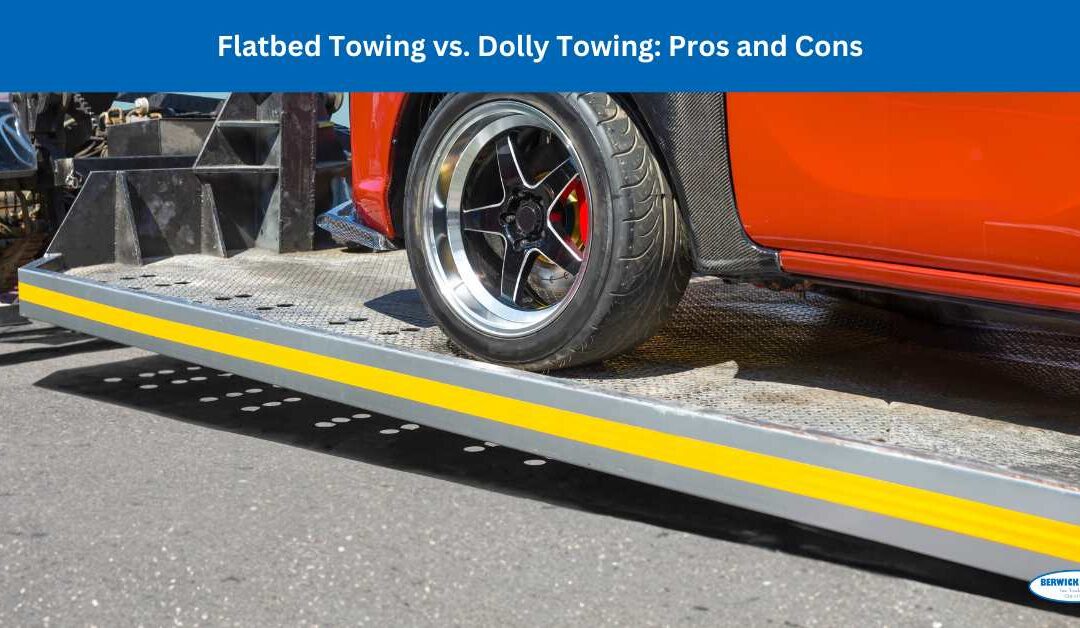When selecting between flatbed towing and dolly towing, it’s essential to consider factors like vehicle type, distance, and budget. Each method has its strengths and limitations, so understanding these can help you decide the best towing approach for your needs.
Flatbed Towing
Flatbed towing involves securing the entire vehicle on a flat truck bed, with all wheels lifted off the road. The vehicle is either driven or winched onto the bed and securely fastened in place.
Pros of Flatbed Towing
- Increased Protection
With the vehicle completely off the ground, there’s no risk of wear on tires, transmission, or suspension. This method is excellent for preserving the vehicle’s condition.
- Versatility
Flatbeds can tow almost any vehicle type, including all-wheel drive (AWD), four-wheel drive (4WD), and low-clearance or luxury cars.
- Greater Stability
Flatbed towing reduces sway and fishtailing since the vehicle is firmly secured on the truck bed, making it ideal for highway speeds and rough terrain.
- Enhanced Safety
The risk of accidents is minimized with all four wheels on the flatbed, providing extra peace of mind for longer journeys.
Cons of Flatbed Towing
- Higher Cost
Flatbed towing is usually more expensive due to the specialized equipment and additional labor required.
- Less Maneuverable
Flatbed trucks are larger and more challenging to navigate in tight spaces or low-clearance areas.
- Availability
Depending on location, flatbed trucks may not be as readily available, especially in rural or remote areas.
Dolly Towing
Dolly towing lifts the front wheels of the vehicle onto a dolly, leaving the rear wheels in contact with the road. It’s commonly used for short-distance towing of front-wheel-drive (FWD) vehicles.
Pros of Dolly Towing
- Affordability
Dolly towing is often less expensive than flatbed towing, making it a cost-effective choice for short distances.
- Ideal for Front-Wheel Drive Vehicles
Towing an FWD vehicle with a dolly avoids potential transmission damage since the driving wheels are lifted off the ground.
- Compact and Lightweight
Tow dollies are smaller and easier to maneuver, which is convenient for tighter spaces and urban areas.
- Availability for Rent
Dollies are commonly available for rental, making them a practical choice for personal or temporary towing needs.
Cons of Dolly Towing
- Limited to FWD Vehicles
Dolly towing is typically unsuitable for rear-wheel-drive (RWD), AWD, or 4WD vehicles, as it can cause drivetrain damage when the back wheels are on the ground.
- Potential Wear and Tear
With the rear wheels on the road, dolly towing can cause wear on tires and other components, especially over long distances.
- Less Stability
Dolly towing can lead to swaying or fishtailing at higher speeds, which can be challenging to manage on highways or rough roads.
- Complex Loading and Unloading
Loading a vehicle onto a dolly requires more alignment and can be tricky for beginners, especially if the vehicle isn’t running.
Final Thoughts
Both flatbed and dolly towing have their specific applications, and the choice depends on your vehicle type, budget, and towing distance. Flatbed towing offers comprehensive protection and stability, while dolly towing is an affordable and accessible option for short hauls.
If you are in Berwick, Victoria 3806, Australia, and looking for a car removal service, this is the best way to visit us.
Contact Us
Berwick Towing & Transport
27B William Rd
Berwick VIC 3806
(03) 7035 7815
www..berwick-towing.com.au/

